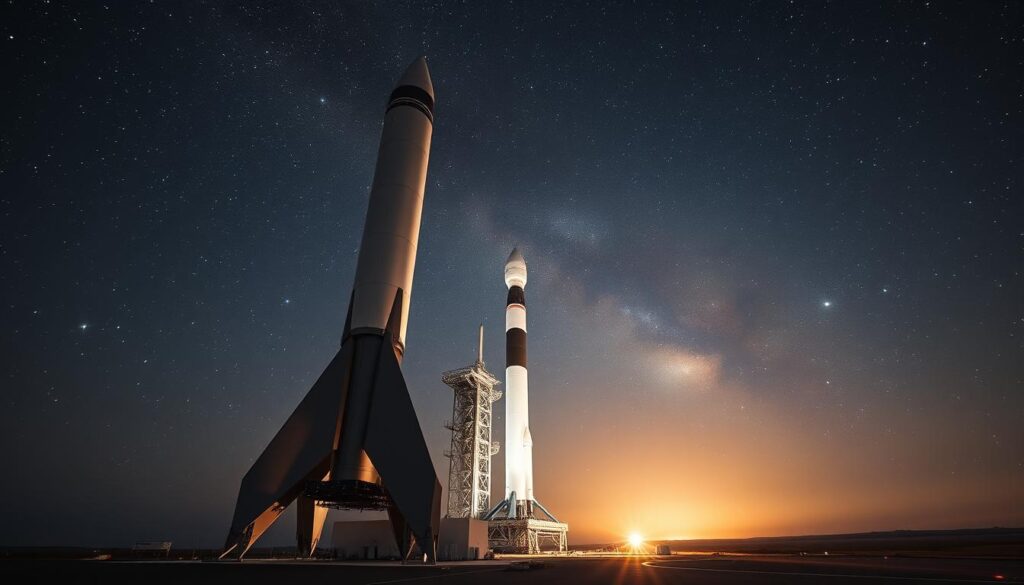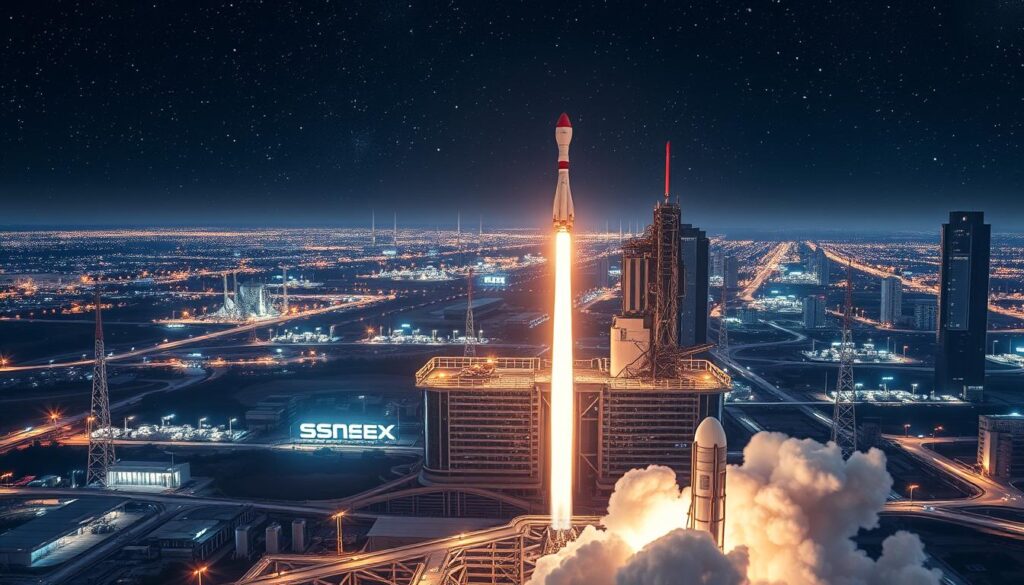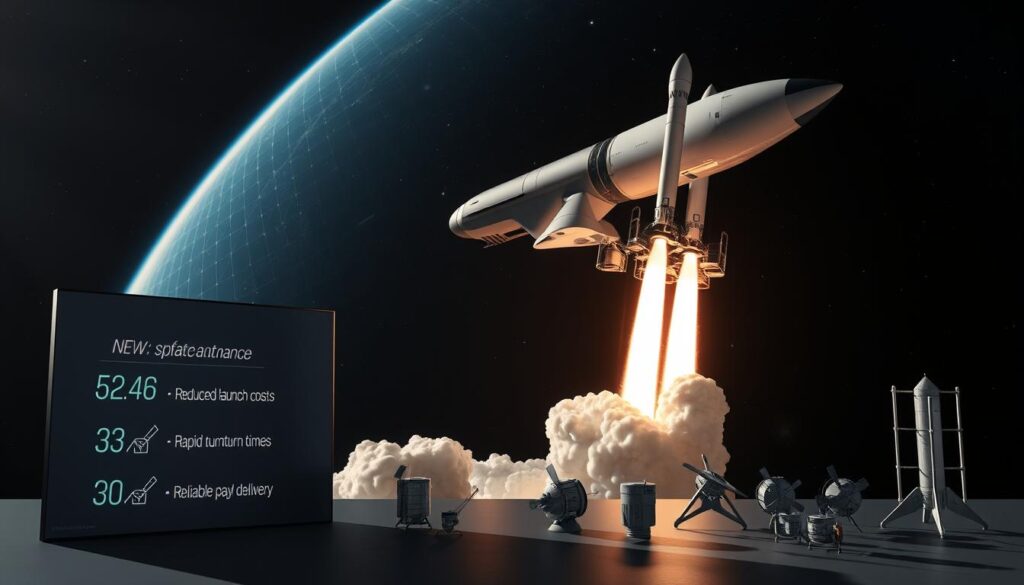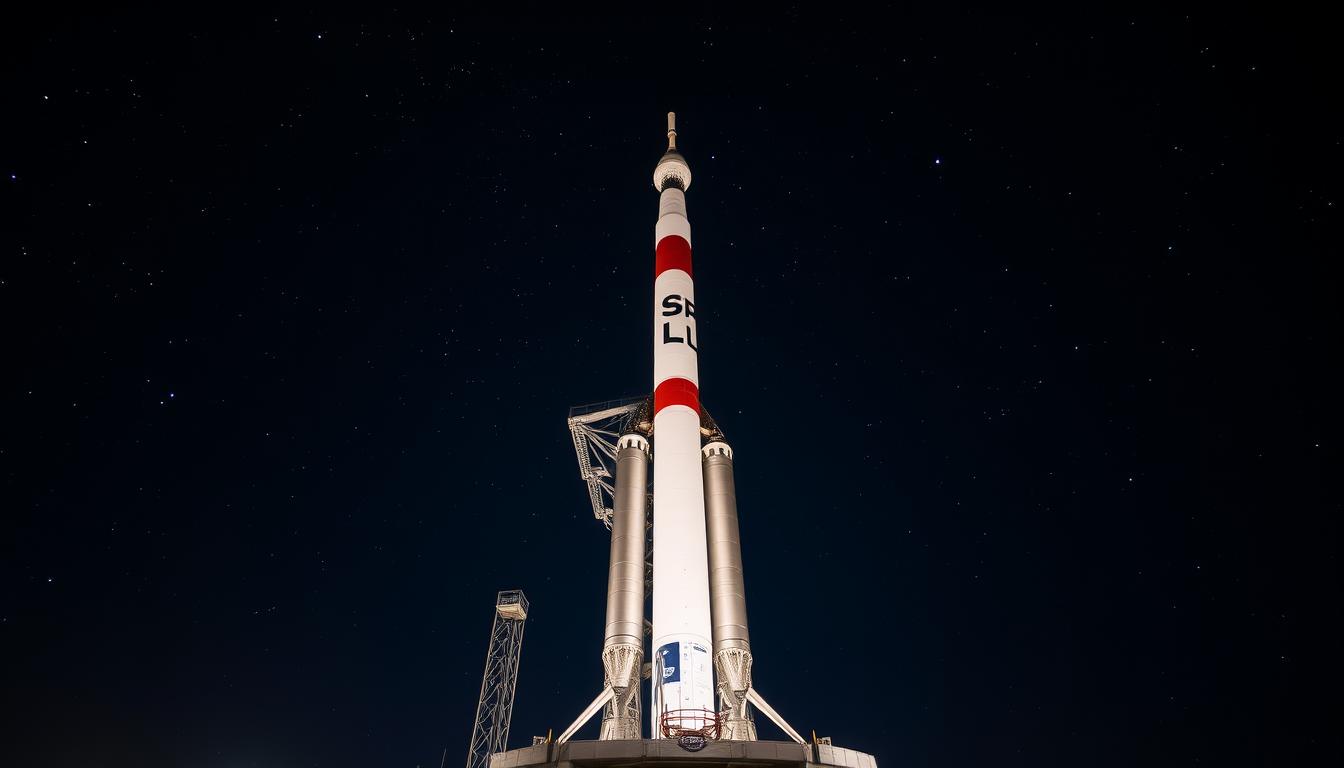SpaceX has been at the forefront of space exploration, leveraging its reusable rocket technology to significantly reduce costs and increase launch frequency. This innovative approach has disrupted the traditional space industry, creating new opportunities for investment and growth. With business growth strategies focused on reducing expenses, SpaceX has become a leader in the commercial space sector, offering investment opportunities that are attracting attention from investors and stock market insights experts. The company’s commitment to reusable rocket technology has also led to increased startup funding, as more entrepreneurs and investors look to capitalize on the growing demand for space-related services.
As the space industry continues to evolve, SpaceX is well-positioned to capitalize on emerging trends and technologies. With a strong focus on innovation and sustainability, the company is driving growth and expansion in the commercial space sector. From satellite launches to deep space missions, SpaceX is pushing the boundaries of what is possible, and its reusable rocket technology is at the heart of this effort. By reducing the cost of accessing space, SpaceX is enabling new opportunities for scientific research, exploration, and development, and its impact is being felt across the industry.
Key Takeaways
- SpaceX’s reusable rocket technology has reduced the cost of traveling to space by a hundredfold compared to traditional single-use rockets.
- The company’s investment in reusable launch technologies exceeds $1 billion, demonstrating its commitment to innovation and sustainability.
- SpaceX’s approach to rocket development has enabled reduced per-unit costs through economies of scale, increasing launch frequency and producing rockets in larger quantities.
- The company’s Starlink project aims to facilitate global internet access through satellite technology, impacting operations in sectors such as business, emergency response, and education.
- SpaceX’s commitment to reusable rocket technology has significantly lowered launch costs compared to traditional one-time-use rockets, making space travel more accessible and affordable.
- The company’s focus on sustainable practices and environmental responsibility is driving growth and expansion in the commercial space sector, and its impact is being felt across the industry.
The Genesis of SpaceX: From Startup to Space Industry Giant
SpaceX, founded in 2002 by Elon Musk, has revolutionized the space industry with its innovative approach to space transportation. With a focus on reducing costs and enabling the colonization of Mars, the company has become a leading player in the industry. The early days of SpaceX were marked by significant challenges, but the company’s commitment to AI and machine learning helped it overcome these hurdles and achieve remarkable success.
The company’s growth was fueled by early funding rounds and strategic investments, including those from the Capricorn Investment Group, which manages over $8 billion in multi-asset class portfolios. The Technology Impact Fund, with its focus on investment opportunities that address global problems, also played a crucial role in supporting SpaceX’s mission. By leveraging cloud computing solutions and web development trends, SpaceX was able to streamline its operations and improve efficiency.
As the company continued to grow, it prioritized cybersecurity best practices to protect its sensitive data and ensure the security of its systems. This focus on security has been essential in maintaining the trust of its customers and partners, including NASA, with which SpaceX has collaborated on numerous missions. With its impressive track record of success, SpaceX is poised to continue shaping the future of space exploration and commerce.
Key milestones in the company’s development include the successful launch of over 190 missions, a valuation of approximately $137 billion, and the development of the Starship system, which aims to reduce space travel costs by up to 90%. As SpaceX continues to push the boundaries of space technology, its commitment to innovation and AI and machine learning will remain essential to its success.
Understanding SpaceX’s Revolutionary Reusable Rocket Technology
SpaceX’s reusable launch system development program, announced in 2011, has revolutionized the space industry. By leveraging digital marketing strategies and SEO best practices, SpaceX has effectively promoted its innovative technology, increasing launch frequency and reducing the cost of space access.
The company’s approach to rocket design and manufacturing has been instrumental in its success. With a focus on SaaS marketing and social media marketing, SpaceX has been able to reach a wider audience, showcasing its achievements and building a strong brand presence.
Some key milestones in SpaceX’s reusable rocket program include:
- First successful landing and recovery of a first stage in December 2015
- First re-flight of a landed first stage in March 2017
- Third reflight in October 2017 during the SES-11/EchoStar-105 mission

By adopting reusable rocket technology, SpaceX has significantly reduced space debris and environmental impact, aligning with sustainable space exploration goals. As the company continues to push the boundaries of space technology, its innovative approach to marketing and promotion will remain crucial to its success.
| Milestone | Date |
|---|---|
| First successful landing and recovery of a first stage | December 2015 |
| First re-flight of a landed first stage | March 2017 |
| Third reflight | October 2017 |
Business Growth Strategies: SpaceX’s Path to Market Dominance
SpaceX has achieved remarkable success in the space industry through its innovative business growth strategies. By focusing on fitness and nutrition for its employees, the company promotes a healthy work environment, leading to increased productivity and job satisfaction. This approach is also reflected in its mental health awareness initiatives, which prioritize the well-being of its team members.
One key aspect of SpaceX’s growth strategy is its vertical integration model, which enables the company to design, manufacture, and launch its own rockets and spacecraft. This approach has led to significant cost reduction through innovation, making SpaceX a more competitive player in the market. The company has also formed strategic partnerships with key players in the industry, including NASA and the U.S. military, securing a steady stream of contracts and revenue.
Key Factors Contributing to SpaceX’s Success
- Investment in research and development to drive innovation
- Focus on weight loss programs for its rockets, reducing launch costs and increasing efficiency
- Adoption of holistic medicine approaches to maintain a healthy and balanced work environment
- Strategic partnerships with key industry players to secure contracts and revenue
By prioritizing the well-being of its employees and adopting a holistic approach to business growth, SpaceX has established itself as a leader in the space industry. The company’s commitment to innovation, cost reduction, and strategic partnerships has enabled it to achieve remarkable success and dominate the market.
Financial Impact of Reusable Rockets on Space Industry
The financial impact of reusable rockets on the space industry has been significant, with costs reduced by up to 30%. This reduction in cost has created new opportunities for investment and growth, much like how online learning platforms have made education more accessible. As the space industry continues to evolve, it’s essential for professionals to stay up-to-date with the latest career development tips to remain competitive.
In addition to cost savings, reusable rockets have also enabled the launch of smaller satellites and payloads, creating new opportunities for investment and growth. This shift towards smaller, more efficient satellites is similar to how home workout routines have changed the way people approach fitness, making it more accessible and convenient.

The economic model of reusable rockets spreads development and manufacturing costs across multiple missions, improving overall cost efficiency in satellite deployment and resupply missions. This cost efficiency is expected to drive growth in the space industry, with the market projected to exceed trillions in market value.
| Launch Vehicle | Launch Cost |
|---|---|
| SpaceX Falcon 9 | $62 million |
| SpaceX Falcon Heavy | $90 million |
| NASA’s Space Launch System (SLS) | $2 billion |
As the space industry continues to grow, it’s essential for professionals to stay adaptable and committed to continuous learning, much like how they would approach online learning platforms or career development tips. By doing so, they can remain competitive and take advantage of the new opportunities created by reusable rockets.
Investment Opportunities in the Commercial Space Sector
The commercial space sector has experienced significant growth in recent years, with investments reaching $10 billion in 2021. This growth is expected to continue, with the global space sector valued at over $469 billion and projected to grow up to 11% per annum. As the industry expands, it creates new freelancing opportunities and remote job trends that can benefit from specialized resume writing services.
Investors can choose from various options, including venture capital, private equity, and public markets. Some notable investments include Astranis Space Technologies’ $250 million raise at a $1.4 billion valuation and Relativity Space’s $650 million financing. Successful space start-ups often target large addressable markets with near-term revenue potential and possess proprietary technology and proven leadership teams.
Key investment areas in the space sector include:
- Upstream activities: spacecraft manufacturing and launch vehicles
- Midstream activities: spacecraft operations and in-orbit management
- Downstream investments: spacecraft-derived data, applications, and services
The space sector’s growth is driven by increasing demand for commercial space services, such as satellite communications and earth observation. As the industry continues to evolve, it is essential for investors to assess risk assessment factors and consider the potential for long-term growth and returns.
| Investment Area | Number of Companies | Total Investment |
|---|---|---|
| Upstream | 210 | $22.6bn |
| Midstream | 152 | $5.6bn |
| Downstream | 267 | $19.6bn |
SpaceX’s Competitive Advantages in the Global Market
SpaceX has established a strong competitive position in the global market, leveraging its cost leadership position, technological superiority, and effective market positioning strategy. By applying email marketing tips and social media marketing strategies, the company has successfully promoted its services and products, including its reusable rockets and satellite launches.
In the context of the dropshipping business, SpaceX’s ability to reduce launch costs through reusable rockets has significantly impacted the space industry. This cost reduction has enabled the company to offer competitive pricing, making its services more attractive to customers.
Some key competitive advantages of SpaceX include:
- Cost leadership position through reusable rockets
- Technological superiority in rocket design and manufacturing
- Effective market positioning strategy through strategic partnerships and marketing efforts
By focusing on innovation, customer satisfaction, and strategic partnerships, SpaceX has maintained its competitive edge in the global market. The company’s commitment to reducing environmental impact and promoting sustainability has also contributed to its strong market position.

As the space industry continues to evolve, SpaceX is well-positioned to remain a leader, driven by its innovative approach to space technology and its commitment to customer satisfaction. By leveraging its competitive advantages and continuing to invest in research and development, SpaceX is poised for long-term success in the global market.
| Competitive Advantage | Description |
|---|---|
| Cost Leadership | Reusable rockets reduce launch costs |
| Technological Superiority | Innovative rocket design and manufacturing |
| Market Positioning | Strategic partnerships and marketing efforts |
Impact on NASA and Traditional Space Programs
The emergence of SpaceX’s reusable rocket technology has significantly impacted NASA and traditional space programs. With cost savings and increased launch frequency, this technology has enabled the launch of smaller satellites and payloads, creating new opportunities for investment and growth. As the space industry continues to evolve, it’s essential to adopt SEO best practices and digital marketing strategies to stay ahead of the curve.
The global Space Economy has experienced significant growth, with a total value of $570 billion in 2023. Commercial activities accounted for approximately 78% of this value, highlighting the importance of social media marketing and online presence in the industry. Key statistics include:
- 186 successful rocket launches in 2022, representing a 22% increase from the previous year
- SmallSats accounted for about 95% of spacecraft launched in 2022
- The global space sector attracted approximately $272 billion in private equity investments from 2013 to 2022
As the space industry continues to expand, it’s crucial for companies to adapt to emerging trends and technologies. By embracing digital marketing strategies and SEO best practices, companies can stay competitive and thrive in this rapidly evolving market.
Future Market Projections and Growth Potential
The space industry is poised for significant growth, with business growth strategies playing a crucial role in its development. Companies like SpaceX are at the forefront of this growth, with investment opportunities in startup funding and stock market insights becoming increasingly important.
Some key statistics that highlight the potential of the space industry include:
- The commercial space industry is projected to reach $1 trillion in revenue by 2040.
- Spacerews’s launch costs have decreased by up to 70% compared to traditional rocket launches.
- The global satellite market is expected to grow to $72 billion by 2030.
With the demand for space-based services on the rise, companies are looking for innovative business growth strategies to stay ahead in the market. This includes exploring new investment opportunities and leveraging stock market insights to make informed decisions.

As the space industry continues to evolve, it will be interesting to see how companies adapt and grow, and how startup funding and investment opportunities contribute to this growth.
| Year | Projected Revenue | Growth Rate |
|---|---|---|
| 2020 | $9.25 billion | 15% |
| 2025 | $20 billion | 20% |
| 2030 | $50 billion | 25% |
Environmental and Social Implications of SpaceX’s Technology
As SpaceX continues to push the boundaries of space exploration, its technology has significant environmental and social implications. The use of AI and machine learning in rocket development has improved efficiency and reduced costs. However, the recent explosion of SpaceX’s Starship rocket has raised concerns about the potential environmental impact of such incidents.
The explosion created a major debris field, affecting the local environment and wildlife. This incident highlights the need for cybersecurity best practices to prevent such accidents and ensure the safe operation of space technology. Furthermore, the increasing number of satellite launches has led to concerns about space debris and orbital crowding, emphasizing the importance of cloud computing solutions for data management and analysis.
The growth of the space industry has also led to an increase in web development trends, with many companies investing in space technology and exploration. As the industry continues to expand, it is essential to consider the environmental and social implications of space exploration and development. By prioritizing sustainability and responsible innovation, we can ensure that the benefits of space technology are shared by all, while minimizing its negative impacts.
Some of the key concerns and considerations include:
* Space debris and orbital crowding
* Environmental impact of rocket launches and explosions
* Cybersecurity risks and threats
* Social implications of space exploration and development
* The need for sustainable and responsible innovation in the space industry
The space sector is projected to grow into a trillion-dollar market within the next 20 years, and it is essential that we prioritize environmental and social sustainability to ensure that this growth is responsible and beneficial for all.
Conclusion: SpaceX’s Role in Shaping the Future of Space Commerce
As the global space economy continues to evolve, the impact of SpaceX’s revolutionary reusable rocket technology cannot be overstated. The company’s innovative approach has not only disrupted the traditional space industry but also paved the way for new opportunities in SaaS marketing, digital marketing strategies, SEO best practices, and social media marketing.
The projected growth of the space economy, estimated to reach $1 trillion by 2040, highlights the immense potential for commercial space ventures. SpaceX’s dominance in the satellite launch market, capturing 60% of the global share in 2021, demonstrates its ability to capitalize on this burgeoning industry. As the cost of launching payloads continues to drop due to advancements in reusable rocket technology, the space sector becomes increasingly accessible to new players and investors.
With the rise of the “New Space” industry, the importance of effective marketing and online presence cannot be overstated. SpaceX’s success serves as a testament to the power of strategic digital marketing and SEO in capturing market share and reaching a global audience. As the space industry evolves, companies must adapt their SaaS marketing and social media marketing strategies to stay ahead of the curve and capitalize on the growing opportunities in space commerce.
FAQ
What are the benefits of SpaceX’s reusable rocket technology?
SpaceX’s reusable rocket technology has significantly reduced the cost of space launches and increased the frequency of launch opportunities. This has had a transformative impact on the space industry, making space exploration and satellite launches more accessible and affordable.
How has SpaceX’s innovative approach to rocket design and manufacturing contributed to its success?
SpaceX’s focus on technological advancements, including the use of AI, machine learning, cloud computing solutions, and web development trends, has allowed the company to continually improve its rocket design and manufacturing processes. This has led to increased efficiency, cost savings, and a competitive edge in the global space market.
What are the key business growth strategies that have helped SpaceX maintain its market dominance?
SpaceX’s success can be attributed to its vertical integration model, cost reduction through continuous innovation, and strategic partnerships with key players in the space industry. The company’s emphasis on fitness, nutrition, mental health, and holistic practices has also contributed to its overall business growth and sustainability.
What are the investment opportunities in the commercial space sector, and how does SpaceX fit into this landscape?
The commercial space sector offers a range of investment opportunities, including direct investment in space companies like SpaceX, as well as related industry investments. Investors should carefully assess the risks and potential rewards of these investments, considering factors such as market trends, regulatory changes, and the competitive landscape.
How has SpaceX’s reusable rocket technology impacted traditional space programs, such as NASA?
SpaceX’s reusable rocket technology has significantly reduced the cost of space missions and increased launch frequency, benefiting both commercial and government space programs, including NASA. This has allowed for more ambitious and cost-effective space exploration and satellite deployment initiatives.
What are the environmental and social implications of SpaceX’s reusable rocket technology?
SpaceX’s reusable rocket technology has the potential to reduce carbon emissions and increase access to space, making space exploration and commercial space activities more sustainable. However, the company must also address cybersecurity risks and ensure responsible innovation to mitigate any negative environmental or social impacts.



